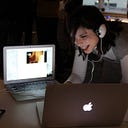Making sense of Positionality
For most of my professional life, I’ve found myself designing digital products, services and communication pieces to which I could be the user or recipient. Imagining, simulating and trying out a product or service for myself has been a handy head start as a designer. Nevertheless, there’s always more to the story. Firstly, this should never substitute researching and testing with diverse users. Secondly, it shouldn’t hinder recognising what we might take for granted or be oblivious to. And I’ve found this second point especially important when designing services I will not use. This is where positionality comes in.
Here’s a quick example. Designing a digital mental well-being service for young people means we must understand and consider the context in which young people grow up and act today. This context will determine both the limitations they may experience and the motivations they feel. As an ‘adult’, we are very far removed from their reality, and we may make assumptions based on our upbringing, our life as it is today or even what we see in movies. So, what assumptions are we making about how young people will use the service? Will they have access to a suitable device to use the service? Does the language used captivate or deter their engagement? Do they have time to use the service? Is it culturally acceptable for them to use the service? Could parental controls or content restrictions stop them from accessing relevant information? And so many more questions that, when unanswered, can be dangerous blind spots.
Positionality is how our context, social experience, position and status influence our identity, how we behave and see the world and our access to different aspects of the social world around us. This positionality creates certain predispositions that enhance or limit how we interpret and act within the world. It will influence our choices when designing and developing products and services. David Takacs asks: “How does who you are shape what you know about the world?”
“They’ve been taught that truths are discovered irrespective of the discoverer’s identity. They see themselves as unbiased conduits for reporting objectively derived facts, and are not comfortable presenting themselves as knowledge makers whose own lives count as factual evidence about the world.”
How Does Your Positionality Bias Your Epistemology? — David Takacs
Why does it matter?
Someone asked me the other day: How can we remove bias from technology? I found the question troubling. Is it really possible to create a piece of neutral, unbiased technology that is not affected by positionality? Technology is a tool. A tool always has a function and purpose. {Sidetrack: A fork is always biased towards poking, even though it might not discriminate towards what it pokes. So it can be used for good or bad.} Technologies have a creator and will always be applied/used within a culture, a geographical location, a community, etc. They will often replicate or enhance the aims within a society. Technologies require choices to be made by creators, service providers and users when creating, delivering and using services.
Let’s take the example of software that scans everything a student writes on their school computer for signs of distress and self-harm. What words/terms are flagged? Which ‘writing’ is it applied to (e.g. private/personal messages, school work)? What languages does it recognise? What harms to look for? Who is to be notified about words flagged? Is the user aware and in agreement with this scanning? What actions to take (e.g. safety or punishment measures)? In making these choices when designing the technology, we are embedding in it what we know, or what we think we know, our ideas of how the world works or how it should work, who we believe should be protected and how they should be protected. So, it matters to collectively consider these choices in the design process and co-create these services with our users. (Again, especially when we are not the users of the service we are developing.)
What should we consider? Some emerging incomplete thoughts…
- Identifying knowledge we take for granted and challenging our assumptions: Where did this knowledge come from? How did we build it? What are our blind spots? And does it hold true in other contexts?
- Practice listening with curiosity, not judgment: to understand how others might interpret the world and what impact that may have on their behaviours and decisions. “Through recognising and analysing the cultures in which we are positioned, and that therefore cannot help but mould our worldviews” (David Takacs)
- Creating space for “strong objectivity” (argued by Sandra Harding), is the act of a creator, whether that is a researcher, a designer, a developer, an organisation, etc., acknowledging who they are and how they interpret the world has an impact on what they produce and its impact on the world, as opposed to claiming to be neutral.
Accepting that what I design is not neutral helps me make purposeful decisions when designing, and recognise that all choices have an impact and build towards a society we want to live in.
